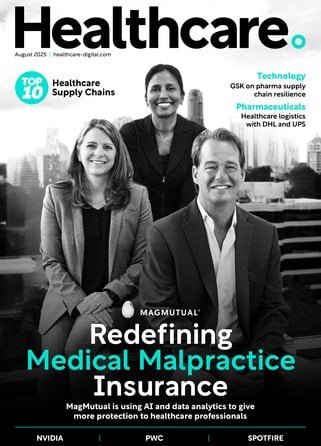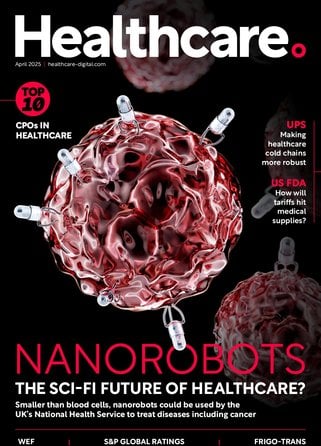Infosys Consulting: the future of AI and automation in healthcare

Global Head for Artificial Intelligence and Automation, John Gikopoulos, on how AI and machine learning is disrupting the healthcare ecosystem.
“The robots aren’t taking over; it’s a misconception that’s really important to move away from,” says John Gikopolous, Global Head for Artificial Intelligence and Automation at Infosys Consulting. “Unfortunately - or perhaps fortunately - the future isn’t Pepper the Humanoid Robot, and the greater use of AI, machine learning and robotic process automation (RPA) in healthcare doesn’t mean we’ll end up with some vision of Arnold Schwarzenegger’s Terminator diagnosing us or deciding whether we live or die.
“The reality is that around 80%, and in some cases more, of activities that happen in hospitals are process or operations-driven, rather than focused on actual healthcare,” he continues. “And while you’ll see lots of hype around how AI and other new technologies can change the way that patients interact with doctors and the wider healthcare system, the most significant changes have happened at that automation and simplification level - we’ve come to work with, and rely on these innovations on a day-to-day basis without even realising they exist.”

The healthcare industry offers great potential for adopting new technologies such as AI, machine learning and automation, particularly with regards to driving down operational efficiencies, enhancing quality of care and patient engagement, as well as reducing cost of care. Some reports have suggested, for example, the market for AI in healthcare could grow by as much as 40% by 2021 to be worth $6.6bn. For Gikopoulos, the use of machine learning technologies in clinical trials has the potential to improve efficiency by as much as 30%, while AI and automation applications have likely already improved the overall efficiency of the healthcare ecosystem by between 10% and 15%.
“It’s primarily what these technologies do,” he says. “They simplify, standardise and make processes and operations more effective and efficient. Look at how we interact with healthcare. The process 10 years ago was very manual - you had to book appointments yourself, make a call, physically visit hospitals, physicians or clinics, but today that’s changed across the entire payer to provider value chain. Our life is changing on a daily basis on a level that is unprecedented and which, more interestingly, we don’t fully understand. Everything, irrespective of whether we’re a consumer or a patient, a user or a healthcare professional has been made easier by these technologies across the entire ecosystem.”

AI in healthcare: technology transformation
According to Gikopoulos, there are four key areas of disruption related to AI and automation in the healthcare industry: intelligent process automation, standardisation of the way in which patient data is classified, optimising patient treatment, and interfacing with patients.
“Across these four key levers, the payer and provider sector is differentiated by the margins and the relative financial stability of the players within the respective ecosystem,” he explains. “At the one end is public healthcare, public hospitals and primary care, which has to focus on efficiency and effectiveness and is never going to be the most affluent part of the value chain. At the other extreme are the pharma companies and so on, which have margin levels that most other industries are envious of. Across this value chain is where you see a different emphasis on those four trends, and the achieving of efficiencies and effectiveness that AI technology can bring. It also expedites the adoption of technology.
“On the provider side, for example, there have been vast levels of efficiencies and greater effectiveness achieved through automation and the standardisation of information. Something more evident in the big payer-provider interface is around the way in which individuals, consumers, users and patients interact with the healthcare sector. This is where chatbots, intelligent interactive voice recognition (IVR), telematics, avatars and all of those various remote and or non-remote channels of interaction come in.”
Four key AI in healthcare trends
-
Intelligent Process Automation
“This is the central one,” says Gikopoulos. “Automation, RPA and IPA should really be running all of the various solutions in the background. From the payer perspective, it’s about collecting information, registering people, allowing one-point access to past information and so on; from the provider side, the entire experience in a hospital should be underpinned by automated processes. For pharma companies, for example, automation is used across all functions, from manufacturing and support, through IT, finance and even the running of clinical trials and R&D.”
The key advantage of RPA and IPA is the skipping of the human interface, according to Gikopoulos. Employing the technologies removes the delays or mistakes that humans make from the equation, thus making the entire value chain more efficient from end to end.
-
Standardising data
“The biggest problem across the entire healthcare value chain is being able to call the same thing the same name at every stage of the process, so underlying or diagnosed conditions of a patient, the effect of different treatments - or a lack of treatment - has had in the past and so on,” Gikopoulos explains. “It drives every decision, from what active agents go into drugs and when to dispense then, through to clinical trials, how long people should be hospitalised and even what impact they may have on the greater public and the healthcare system.
“And yet, it’s a question that just hasn’t been addressed adequately,” he continues. “Information comes from so many sources in healthcare that standardising that information is essential. Further, once you have that standardisation, then you can apply AI to identify the questions behind that information.
-
Machine learning
Machine learning is used at the payer/patient or hospital/patient interface to analyse data, often provided by patients, and to provide informed reactions and decisions on that data. “When you start looking at the outcomes of treating patients in different ways depending on when they came in - what symptoms they have, what were their underlying conditions, demographic or social category, then you define a completely different decision tree compared to the static, traditional one that says the customer journey or the patient journey is greet at the reception, triage, send to doctor, have it diagnosed and then send to be treated,” notes Gikopoulos.
He also cites the importance of machine learning in clinical trial efficiency, adding that it “could be grossly understated in certain cases”. These include, for example, identifying cause and effect in the use of different agents within drugs along the clinical trial value chain, which can work in a much faster and more targeted way with machine learning.
-
Patient interfacing
According to Gikopoulos patient interfacing can “completely change the experience that we all have from communicating with this entire value chain”. Examples he cites include using remote channels to contact patients that need a certain treatment after discharge, or the use of telematics to remote diagnose patients.
“Interfacing isn’t all about chatbots, avatars or cool looking bots that interact with you,” he says. “To a large extent, it’s more to do with the IoT and making us part of the connected world not just for the mundane and potentially also fun parts of our experience and existence, but also the more crucial areas like healthcare. Imagine, for example, if all our machines, computers, phones and so on, instead of using their enhanced abilities to provide greater gameplay, screens, or sound quality, had actually focused on having the type of sensors that allow temperature or blood pressure to be taken, or a person's retina to be scanned for specific diseases. That kind of interface or interaction could, or might still, completely change everything.”

Catalyst for digital technology
Despite the clear benefits to the deployment of AI and automation technology, the pace of adoption has been slow across several industries including healthcare. Gikopoulos attributes this to a risk averse mindset inherent in all of us, and a strong understanding of the underlying technologies and their ability to improve things in the shorter term. “There’s no way of circumnavigating the technology maturity curve, but you can see why sensitive areas like the healthcare sector would be a later adopter of new innovations.
“Unfortunately, the severity of the coronavirus pandemic is the kind of catalyst that expedites adoption. If you look at the past, it’s little surprise that the biggest changes in the world order have occurred during war time or periods of significant disruption. It brings a situation where people are willing to spend what is needed to achieve results, there is greater alignment between stakeholders to work towards a specific goal, and the emphasis is on getting things done rapidly.”
Future trends
Gikopoulos sees several trends driving future evolution for AI. Distance learning technology and IoT will dominate, he believes, playing a significant role in how people are trained, how they learn, and are on-boarded to organisations.
“There is also huge potential in how AI and automation can improve the entire supply chain,” he adds “due to what I call ‘working type’ scenarios. This basically means predicting where a supply chain may fail and proactively taking action to rectify before there are any issues. This is especially relevant in the healthcare sector because of the life criticality element that is evident within the sector. For me, the biggest difference will come from the use of machine learning to standardise patient data and provide insights into questions that we never knew existed. It could be a real revolution”
Read the latest edition of Healthcare Global to get more of the latest news and insights across every part of the healthcare industry.



